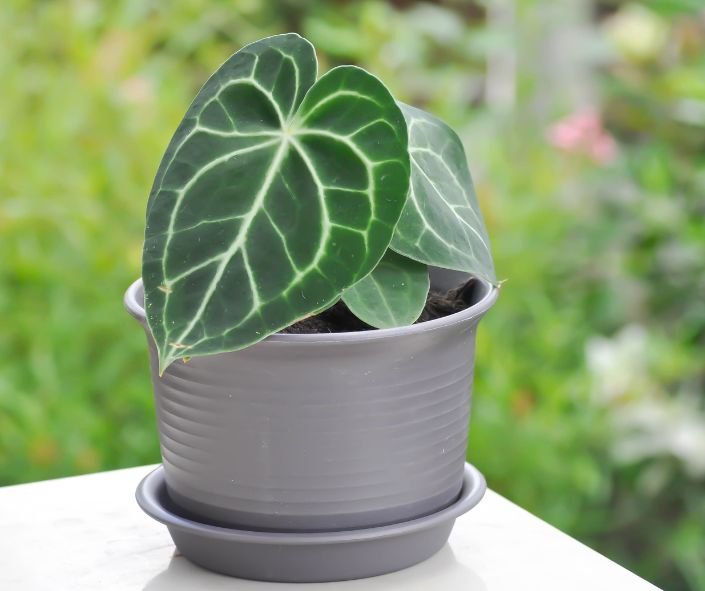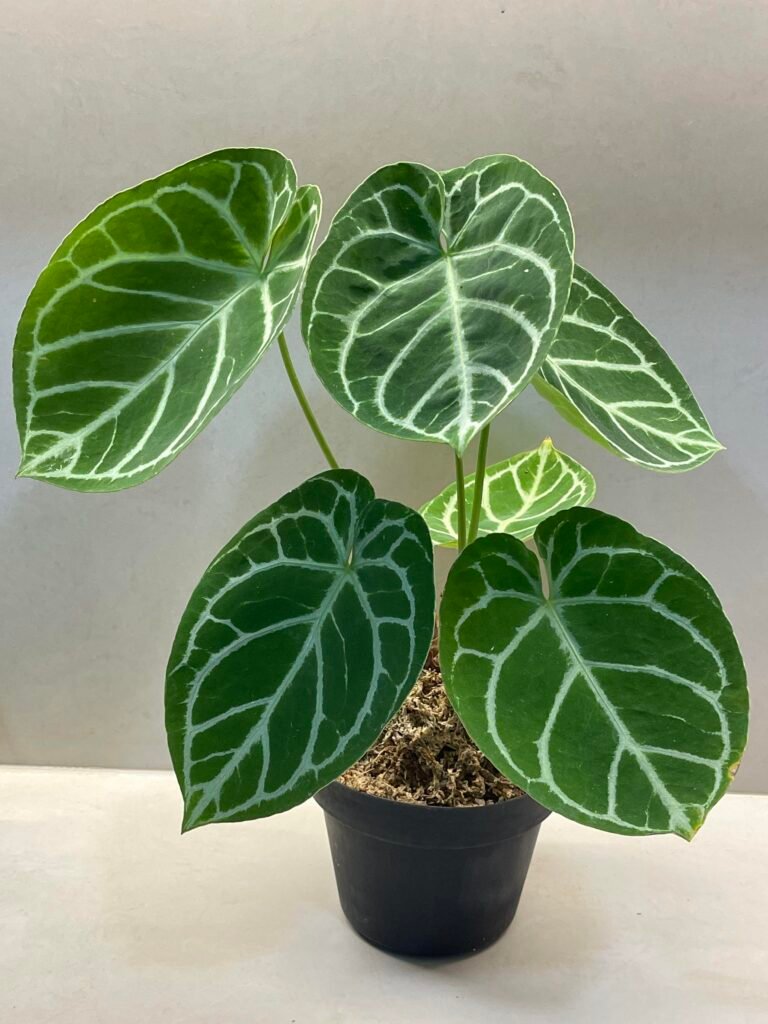Anthurium Besseae is a stunning tropical plant that is prized for its vibrant flowers and lush foliage. In this quick care guide, we will explore everything you need to know about caring for Anthurium Besseae to ensure its health and beauty in your home.

Understanding Anthurium Besseae
Before diving into the care tips, it’s important to have a basic understanding of Anthurium Besseae. This plant is native to the rainforests of Colombia and is known for its heart-shaped leaves and bright red flowers. It is a relatively small plant, reaching a height of about 12 inches, making it perfect for both indoor and outdoor gardens.
Origin and Characteristics of Anthurium Besseae
Anthurium Besseae is endemic to the Tarapoto region in Peru. It was discovered in the mid-20th century and has since become a popular choice among plant enthusiasts. This species is known for its unique characteristics, including its waxy leaves, compact growth habit, and vibrant flower coloration.
The Tarapoto region, where Anthurium Besseae originates from, is a lush and biodiverse area in Peru. It is home to a wide variety of plant and animal species, including many rare and endangered ones. The rainforests in this region are teeming with life, with vibrant colors and unique sounds filling the air.
Anthurium Besseae’s heart-shaped leaves are not only visually appealing but also serve a purpose in its natural habitat. These leaves have a waxy coating that helps them retain moisture, allowing the plant to thrive in the humid rainforest environment. The compact growth habit of Anthurium Besseae makes it well-suited for small spaces, making it a popular choice for urban gardens and indoor plant collections.
One of the most captivating features of Anthurium Besseae is its vibrant flower coloration. The bright red flowers stand out against the lush green foliage, creating a stunning visual contrast. These flowers not only attract pollinators like bees and butterflies but also add a touch of natural beauty to any setting.
Why Choose Anthurium Besseae for Your Home?

There are several reasons why Anthurium Besseae is a great addition to any home. First and foremost, its striking red flowers add a pop of color and elegance to your interior decor. The vibrant hues of the flowers can instantly brighten up any room, creating a lively and inviting atmosphere.
Aside from its aesthetic appeal, Anthurium Besseae is relatively low-maintenance compared to other plant varieties. This makes it an ideal choice for busy individuals or those who are new to plant care. With proper watering and occasional fertilization, this plant can thrive without requiring constant attention.
Furthermore, Anthurium Besseae is known for its air-purifying properties. Like other plants, it absorbs carbon dioxide and releases oxygen during photosynthesis. This natural process helps improve the air quality in your home, making it healthier and more refreshing to breathe.
Another benefit of Anthurium Besseae is its versatility. It can be grown both indoors and outdoors, allowing you to enjoy its beauty in various settings. Whether you place it on a windowsill, a patio, or even in a hanging basket, Anthurium Besseae will add a touch of natural elegance to any space.
Lastly, Anthurium Besseae is a conversation starter. Its unique characteristics and exotic origins make it an intriguing plant to showcase to friends and family. You can share the story of its discovery in the Tarapoto region and the fascinating details about its growth habits and flower coloration.
In conclusion, Anthurium Besseae is a captivating plant species with its heart-shaped leaves, vibrant red flowers, and low-maintenance nature. Whether you’re a seasoned plant enthusiast or a beginner, this plant is sure to bring beauty and joy to your home.
Red and Green leaves Plants to Elevate Your Holiday Decor
Essential Care Tips for Anthurium Besseae
To ensure that your Anthurium Besseae thrives and remains healthy, pay careful attention to its lighting, watering, temperature, and humidity requirements. Let’s delve into each aspect in detail.
Optimal Lighting Conditions
Anthurium Besseae prefers bright, indirect light. Place it near a window with filtered sunlight to provide it with the perfect lighting conditions. Avoid exposing it to direct sunlight, as this can lead to leaf burn.
When it comes to lighting, it’s important to understand the natural habitat of Anthurium Besseae. This species is native to the rainforests of Ecuador, where it grows under the shade of taller trees. In its natural environment, the plant receives filtered sunlight, which is replicated by placing it near a window with indirect light. This ensures that the plant receives the right amount of light without being exposed to harsh, direct sunlight.
Proper lighting is crucial for the growth and development of Anthurium Besseae. It enables the plant to photosynthesize and produce energy, which in turn promotes healthy foliage and vibrant blooms. By providing the plant with the optimal lighting conditions, you can expect it to thrive and display its beautiful, heart-shaped leaves.
Watering Requirements
When it comes to watering Anthurium Besseae, it’s important to find the right balance. The plant prefers to be evenly moist but not overly saturated. Water it when the top inch of soil feels dry to the touch, and ensure that the pot has proper drainage to prevent waterlogging.
Understanding the watering needs of Anthurium Besseae is essential for its overall health and well-being. In its natural habitat, this species grows in the humid rainforests, where it receives regular rainfall. To replicate these conditions, it’s important to water the plant consistently but avoid overwatering, as it can lead to root rot and other issues.
One way to determine when to water Anthurium Besseae is by checking the moisture level of the soil. By gently inserting your finger into the soil up to the first knuckle, you can assess its dryness. If the top inch of soil feels dry, it’s time to water the plant. However, if the soil feels moist, it’s best to wait before watering again.
Additionally, proper drainage is crucial for Anthurium Besseae. The plant should be potted in a container with drainage holes, allowing excess water to escape. This prevents water from accumulating at the bottom of the pot, which can lead to waterlogging and root rot. Ensuring proper drainage promotes healthy root growth and prevents moisture-related issues.
Temperature and Humidity Preferences
Anthurium Besseae thrives in temperatures between 60°F and 75°F (15°C and 24°C). Keep it away from drafty areas and extremes in temperature. This plant also appreciates high humidity levels, so consider placing it near a humidifier or misting the leaves regularly.
Understanding the temperature and humidity preferences of Anthurium Besseae is vital for its overall growth and well-being. This species is native to the tropical rainforests of Ecuador, where it enjoys warm and humid conditions. By replicating these conditions, you can ensure that the plant thrives and remains healthy.
When it comes to temperature, Anthurium Besseae prefers a moderate range between 60°F and 75°F (15°C and 24°C). It’s important to keep the plant away from drafty areas, such as open windows or air conditioning vents, as sudden temperature fluctuations can stress the plant and affect its growth.
In terms of humidity, Anthurium Besseae appreciates high humidity levels. This can be achieved by placing the plant near a humidifier or by regularly misting its leaves. Increasing the humidity around the plant helps to mimic its natural environment and promotes healthy foliage and vibrant blooms.
By providing Anthurium Besseae with the optimal temperature and humidity conditions, you can ensure that the plant thrives and displays its stunning red flowers. Remember to monitor the temperature and humidity levels regularly to maintain a suitable environment for your Anthurium Besseae.
Red and Green leaves Plants to Elevate Your Holiday Decor
Feeding and Fertilizing Your Anthurium Besseae
To promote optimal growth and vibrant flowers, it’s essential to provide your Anthurium Besseae with proper nutrients. Let’s explore the right fertilizer and feeding schedule for your plant.
Choosing the Right Fertilizer
Opt for a balanced, water-soluble fertilizer with a ratio of 10-10-10 or 20-20-20. This will provide your Anthurium Besseae with the necessary nutrients for healthy growth. Dilute the fertilizer according to the manufacturer’s instructions and apply it every four to six weeks during the growing season.
Feeding Schedule for Healthy Growth
During the dormant season, reduce the frequency of fertilizer applications to every eight weeks. It’s important not to over-fertilize, as this can lead to salt buildup in the soil. Always water your Anthurium Besseae before applying fertilizer to prevent root burn.
Polka Dot Plants : The Ultimate Guide to Growing & Caring
Pruning and Repotting Anthurium Besseae
To maintain the shape and health of your Anthurium Besseae, regular pruning and repotting are necessary. Let’s go over the best practices for each.
When and How to Prune
Prune your Anthurium Besseae in early spring or late winter when it is dormant. Remove any dead, damaged, or yellowing leaves, as well as any leggy or overcrowded stems. Use sterilized pruning tools to prevent the spread of diseases.
Steps to Repot Your Anthurium Besseae
Repotting is recommended every one to two years or when the plant outgrows its current pot. Choose a pot that is one size larger, fill it with well-draining potting mix, and gently remove the plant from its old container. Place the Anthurium Besseae in the new pot, ensuring that the roots are well-covered with soil. Water thoroughly and place it in a location with indirect light until it adjusts to its new home.
Dieffenbachia Varieties: A Spectrum of Dumb Cane Plants
Troubleshooting Common Issues
While Anthurium Besseae is a relatively easy plant to care for, it can encounter some common issues. Let’s take a look at how to identify and overcome them.
Identifying Common Diseases and Pests
Anthurium Besseae is susceptible to a few diseases and pests, including root rot, aphids, and spider mites. Keep an eye out for yellowing leaves, wilting, or any signs of pest infestation. Treat these issues promptly by adjusting the watering schedule, applying appropriate treatments, or seeking advice from a local garden center or plant expert.
Overcoming Growth Problems
If your Anthurium Besseae is not thriving or showing signs of stunted growth, reassess the environmental conditions. Check that it is receiving adequate light, the watering schedule is appropriate, and the humidity levels are sufficient. Adjust these factors accordingly and allow time for the plant to recover.
By following these care tips and providing your Anthurium Besseae with a nurturing environment, you can enjoy its beauty for years to come. Remember to observe your plant closely, cater to its specific needs, and make adjustments as necessary. With a little care and attention, your Anthurium Besseae will reward you with its stunning foliage and vibrant flowers.

Pingback: 10 Philodendron Varieties: A Comprehensive Guide
Pingback: 9 Stunning and Rare Anthuriums – Which One Would You Choose?
Pingback: Anthurium Warocqueanum – Most expensive plant in the world
Pingback: 32 Gorgeous Anthurium Houseplants to Brighten Up Your Home